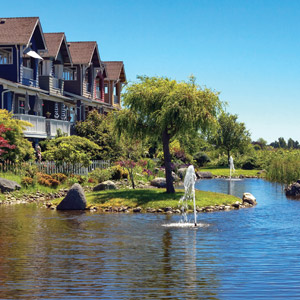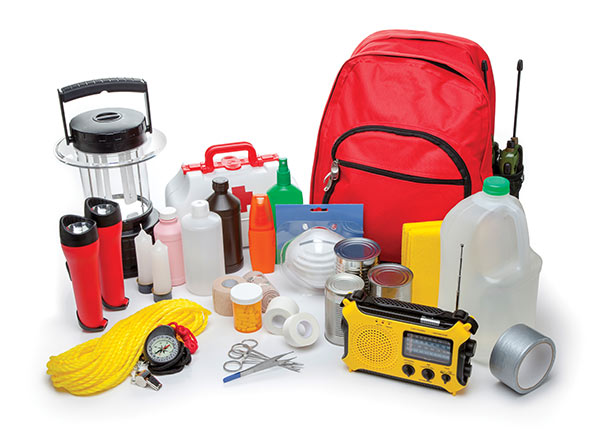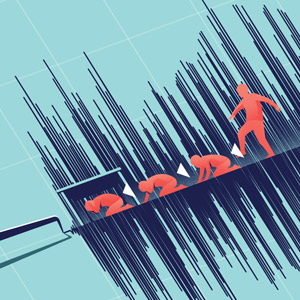Shake Up Call
by Christina Symons | BCAA Magazine, Fall 2018Between the earth’s natural climatic cycles and seismic activity – and a recent upsurge in storms, wildfires and floods attributed to global warming – British Columbians need to be prepared, more than ever, for whatever nature dishes out. Take earthquakes: nearly 3,000 shake the province each year. While most are too small or remote for the average person to detect, seismologists believe a damaging quake in a populated area is only a matter of time. Yet a 2017 study by Emergency Management BC suggests we may not be as prepared as we could be. “Just over half of us have some sort of response plan, but only 13 per cent describe it as complete,” says Shawn Pettipas, BCAA Director of Community Engagement.
Most British Columbians know earthquake risk in BC is relatively high. Vancouver Island-based seismologist Alison Bird has been studying the phenomena for more than 20 years and doesn’t mince words when talking about the chances of a major seismic event in the province.
“BC is the most at-risk province in Canada, and major earthquakes will definitely strike – we simply don’t know when,” she says.
We have a pretty good idea of where, however. The Lower Mainland and coastal regions of BC are the most vulnerable to high-magnitude earthquakes because they lie closest to major faults. The 1,000-km-long Cascadia Subduction Zone, for instance, where one tectonic plate is pushing under another, runs from Vancouver Island to northern California. “[Cascadia] is expected to rupture in a megathrust earthquake as large as about magnitude 9, which includes threat of tsunami,” says Bird. Between this and the many other fault lines crisscrossing the province, the chances of a “significant” (magnitude 6 or greater) earthquake hitting part of BC in the next 50 years are as high as one in three.
When a major earthquake hits, there could be multiple impacts: compromised roads, infrastructure and services (electricity, water, sewer, gas, Internet), as well as damage to buildings. Communities exposed to the open Pacific Ocean, such as Port Alberni, Tofino and Ucluelet, are additionally susceptible to tsunamis, while low-lying areas in Richmond, Tsawwassen and Victoria may be at risk of flooding and strong currents.

Lessons from a shaky past
In the first half of the 20th century, there were several strong (magnitude 6 to 8.1) earthquakes in southwestern BC, but things have been relatively quiet since. “This has lulled many people into a false sense of security,” says Bird.
In 2012, a magnitude 7.8 earthquake set the ground shaking in Haida Gwaii, but there were no casualties and minimal damage. In December 2015, a magnitude 4.8 earthquake hit off the coast of Vancouver Island. Residents felt vibrations as far east as the Fraser Valley and as far south as Seattle, but there was no damage.
According to Bird, the largest and most destructive earthquake in BC’s history occurred January 26, 1700. Local First Nations’ oral-tradition stories speak of communities on the Island’s outer coast being decimated by the quake (which scientists believe to have been magnitude 9) and subsequent tsunami.
Based on the likelihood of a reoccurrence, Bird spends much of her time advocating for a stronger commitment to earthquake safety in BC. “We need to foster a culture of earthquake awareness in this province similar to that in Japan and California,” she says.
Preparation starts at home
If all of this seems frightening, here’s the good news: a damaging quake hasn’t happened yet, and you still have time to protect yourself and your family. Where to start? Since personal injuries due to household hazards are one of the most serious risks in a major earthquake, Pettipas suggests focusing there first:
- Anchor tall and heavy furniture, and any other objects taller than they are wide, to wall studs.
- Move beds away from windows, as glass can shatter in an earthquake.
- Secure appliances like refrigerators, freezers, washers, dryers and water heaters using strong straps or connectors.
- Place heavy items close to the ground and consider guardrails on open shelves.
- Move mirrors and artwork away from above beds and sitting areas, and ensure they’re fastened firmly.
- Secure cabinet doors with latches to prevent them from flying open.
- Keep flammable or hazardous materials in a garage or outside shed to limit the risk of fire or explosion.
Create a family disaster plan
An emergency plan gives your family clear direction in a stressful situation:
- Make a list of family and emergency phone numbers including at least one out-of-area contact, in case nearby regions are affected or local lines overwhelmed.
- Choose a meeting spot away from home such as a neighbour’s house, library or community centre.
- Compile a list of emergency information sources such as local media and government websites and social media channels (@EmergencyInfoBC; emergencyinfoBC.gov.bc.ca).
- Make sure you know how to switch off the utilities. Depending on the damage, you may need to shut off the main electrical breaker, water valve or gas valve.
- Store enough food, water and medication to last three to seven days. You need about four litres of water per person, per day (although children, nursing mothers and sick people may need more, and you may need to double allotments in hot weather). Pets need about 30 mL per kg of body weight per day.
- Keep a pair of shoes and a flashlight under the bed to help with navigating in the dark, potentially on broken glass.
- Create grab-and-go bags, and store them near an exit. Include non-perishable food, water, flashlights, a radio, medications, seasonal clothing, blankets, pens, paper, a phone charger, a first aid kit, cash in small bills, a local map, a whistle and important documents.

MEMBERS SAVE
BCAA Members save up to 20% on home insurance, and enjoy benefits like a $200 deductible, one-claim forgiveness and access to premier packages, which offer enhanced coverage.
Tip!
Drop, cover and hold on! Join BCAA in the Great ShakeOut earthquake drill October 18 at 10:18 a.m.
When the shaking starts
DROP onto your hands and knees to protect yourself from falling.
COVER your head and neck under a sturdy table or desk, or with your arms and hands.
HOLD ON to your shelter (or to your head and neck) until the shaking stops.
After the shaking stops, stay calm and move carefully, watching for dangerous, unstable objects and hazards. Check for injuries and help yourself first, then assist others. Exit immediately if you smell gas, see signs of fire or otherwise suspect the building to be unsafe. Text rather than call loved ones to avoid clogging phone lines, and only dial 9-1-1 for life-threatening situations. Also keep in mind there may be aftershocks. If the shaking starts again: drop, cover and hold on.
Learn more about disaster preparedness at bcaa.com/earthquake
Earthquake insurance 101

The financial burden of replacing personal belongings and repairing damages – or rebuilding completely – after an earthquake could set you back dramatically.
That’s why you should consider earthquake insurance. It protects against many types of direct damage caused by shaking, as well as damages occurring in the aftermath, such as from burst pipes (although damage from tsunamis isn’t covered). It also covers additional living expenses; for example, if you need to leave your home due to damage or during repairs.
What about condos? Strata councils often have earthquake insurance, but they may pass the (pricey) deductibles along to individual condo owners. Strata policies also typically don’t cover the cost of replacing lost possessions, or the living expenses of condo owners who need to relocate while repairs occur. So owners need their own earthquake policies to cover these costs.
The cost of earthquake insurance depends on where you live, your type of property and the total value of the possessions you’re insuring. Contact a BCAA Insurance provider to learn more.
Photo Credits: Eric Chow, iStock








